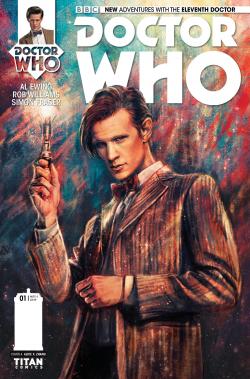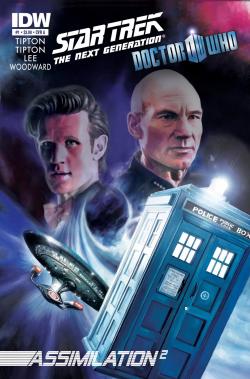Afterlife (Titan Comics)
Thursday, 28 August 2014 - Reviewed by

Afterlife
New Adventures with the Eleventh Doctor
Issue 1
Written by Al Ewing and Rob Williams
Illustrated by Simon Fraser
Coloured by Gary Caldwell
Released 2014 by Titan Comics
And so the Doctor recruits yet another budding travel companion in this tale from Titan Comics. The writing is a combined effort from Al Ewing (Loki: Agent of Asgard, Mighty Avengers, Trifecta) and Rob Williams (Revolutionary War, Ordinary, Miss Fury, The Royals: Masters of War, Trifecta) The artwork comes from Simon Fraser (Nikolai Dante, Grindhouse, Doctor Who) with colour finishing from Gary Caldwell.
Thanks to the flexibility of the Matt Smith era, new companions can slot into the time periods between when the Doctor said goodbye to Amy and Rory and when he 're-acquires' them later. This particular story has just taken place after series 5 finale 'The Big Bang' and uses London as its main setting. Alice Obiefune is the key new character to be introduced in Afterlife. Alice has had a tough time first caring for her severely ill mother and then having to mourn her death. Being made redundant from her assistant librarian job and then having to find a new home as her building was bought for new flats instead just add to her woes. The final insult? Her best friend moving far away to another country altogether.
However the sheer despair gives way to panic and exhilaration. as Alice encounters a beast causing havoc on a busy main road; a simultaneously terrifying and adorable life form with many hues - 'Rainbow Dog'. And not far behind is the Doctor! Humour and exposition are mixed together as the Doctor and Alice establish that they must stop the tail of the creature from performing its natural function - absorbing the environment immediately around it. Eventually things come to a head when the giant creature reaches the Houses of Parliament, where seemingly Prime Minister's Questions is being conducted. Suitably there is a swift interruption and an end to the political debates of the day. Amusingly the desperation from different ministers to make it to the exit before the beast can reach them shows a very firm 'survival of the fittest' mindset.
The Prime Minister - characterised in rather broad brush strokes - comes across as a fair-middling political leader. However his terror in the face of adversity brings into sharp relief the true bravery of Alice. She might be scared, maybe even more than other people. Yet she uses ironic wit (at her own expense!) to alleviate the pressure and to end up helping the Doctor. Beforehand the two had bonded somewhat in the Tardis in a wonderful interlude sequence as she explained her troubled life to the sympathetic 'mad man in a box'. There is a clear chemistry between the two - markedly different however to the Ponds' or Clara's dynamic(s) with him.
Ultimately the solution to stopping the giant multi-coloured dog is simple and elegant - although the Doctor's supposed allies at UNIT almost mess things up by threatening to blow the alien away with their firearms. Thankfully the rainbow dog ends up being reunited with its best friend - a walking squid! Thus the dog/'Kharitite' fits into the Tardis and is allocated a place in the ship's swimming pool. And once again the power of love - so familiar from Matt Smith's run - ends up being the savior of the day. This situation is also rather familiar for any one who has seen 'Hide' from Smith's last full season on TV.
This is a fun story more than not, but a touch confused in tone if read in one go especially. On one hand the sadness Alice must have dealt with to the extremes makes this a downbeat story but there are moments with a lightness of touch as well. The most obvious are the reactions by various people to the Kharitite, and the scenes in Westminster towards the end have a satirical bite For now I will reserve judgement if this a deliberate style choice by the creators,or more of an 'early try' that will be more focused as they pen other stores.
Otherwise Ewing and Williams flesh out the main players in this story quite well although a lot of secondary characters do feel just like window dressing. But importantly the Doctor/ Alice team feels solid from the get-go. And also promising is the apparent set-up for an intriguing arc involving someone from the Doctor's own race - who can appear just about anywhere. I would hope that it is someone else than already familiar renegades from Doctor Who's long history. The artwork from Fraser is excellent here as well, with Gary Caldwell assisting by using both boisterous colour and also shades of grey -to denote Alice's sad life story).
** Two bonus strips feature in this issue:
The first - 'Service with a Shhhh' - explores a banking market opening for the Silence where the Doctor helps out with the marketing side of things. The conceit rests on people forgetting they have money to waste. It is a little less clear just why too great enemies seemingly come together and do something with the same desired end result, but still amusing enough. 'AJ' has fashioned a similar visual style to his Sontaran piece in the Tenth Doctor comic; with computer generated benign-looking 3D Lego type figures. The colours literally leap off the page and add to the overall experience.
The second story - 'Pond Life' (reminding keen fans of Rory and Amy's own mini-series that was on TV) is a rather more traditional and engrossing piece. Both written and drawn by Marc Ellerby it involves the main River Song incarnation we know and love being treated as a young girl by her parents, and despite being physically older than them. Doctor Eleven features briefly as the boy who takes River out for the night - much to Amy and Rory's concern. This more traditional pencil style look is very different from Afterlife but fits the tone of the mini story more than well enough.









